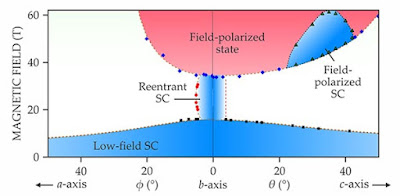 |
| Image source: link below |
Topics: Atomic Physics, Magnetism, Superconductors
Superconductivity and magnetism don’t usually mix. When a superconductor is placed in a magnetic field, it expels the field from its bulk through the Meissner effect; a strong enough field destroys the superconducting state entirely. In the vast majority of superconductors, electrons form spin-singlet pairs, with s– or d-wave symmetry, that are twisted apart by the field. Even the rare p-wave, spin-triplet superconductors (such as strontium ruthenate; see Physics Today, December 2006, page 23) are limited in how strong a magnetic field they can tolerate.
 |
| Web Elements: Uranium Tritelluride |
Last year the list of unusual superconductors grew by one, when Nicholas Butch and colleagues at NIST and the University of Maryland discovered spin-triplet superconductivity in uranium telluride, or UTe2. (The paper reporting their results, although submitted in October 2018, wasn’t published until this August; in the intervening time, the discovery was confirmed by a team of researchers at Tohoku University in Japan and Grenoble Alps University in France.)
Exotic superconducting state lurks at an astonishingly high magnetic field
Johanna L. Miller, Physics Today
Comments